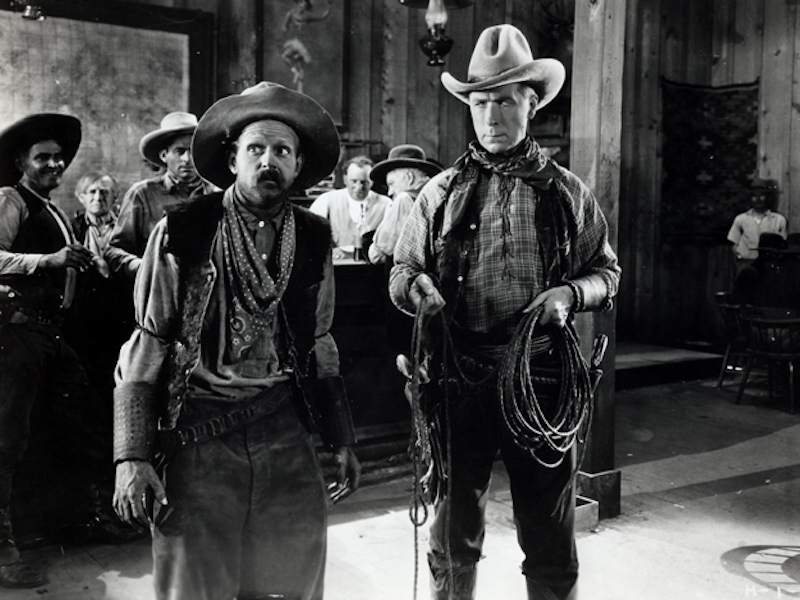[TUMBLEWEEDS: INTRODUCTION]
William Berke (US 1939)
After breaking with Zukor and Lasky, Hart signed a two-picture deal with United Artists, releasing his final feature, Tumbleweeds, in 1925. An elegiac farewell to “the last of the west,” Tumbleweeds was well received by critics and audiences but so badly distributed that Hart took UA to court, ultimately winning a $278,000 damage judgment ($5 million in today’s money). The second film was never made. While that case was still under appeal Hart reissued Tumbleweeds with a recorded score and spoken prologue. Except for Chaplin’s films, silent movies had been considered commercially obsolete for a decade. This attitude had only recently begun to change, starting with a limited reissue of Son of the Sheik and the circulation by the Museum of Modern Art, in both 35 and 16mm, of a selection of programs from their film library. Two Hart films, Keno Bates, Liar and The Taking of Luke McVane — under reissue titles, and with direction incorrectly attributed to Thomas Ince — were now being shown in colleges and universities along with the work of Griffith, Eisenstein, and Carl Dreyer. (After a 1941 flood at his Newhall property destroyed many of his own prints, Hart would donate the surviving material to the Museum.)
Hart may have sensed a groundswell of interest, but he also took advantage of the sudden revival of A-budget westerns. For several years, B-westerns — often featuring singing cowboys like Gene Autry and Roy Rogers — were ubiquitous on American theater screens, lowering the cultural status of a once respectable genre. But in the first four months of 1939 alone, major studios released Jesse James, Stagecoach, The Oklahoma Kid, Dodge City, and Union Pacific. Tumbleweeds reached theaters in May, and despite being handled by Astor, a low-end packager of reissues and orphans, was well received by trade paper critics (although one, Harrison’s Reports, recognized that the projection speed of 90 feet per minute was “much faster” than the original camera speed). Even reviewers who admitted that some elements were stylistically outmoded agreed that the spectacular Oklahoma land rush sequence was the equal of anything they had ever seen. But the highest praise was devoted to Hart’s brief appearance at the start, an emotionally stirring monologue in which the old actor seemed to conflate the closing of the West with a lost age of silent westerns. “My friends, I loved the art of making motion pictures,” he tells us from the screen, startling modern audiences with a declamatory style probably unheard since the days he toured with Modjeska. “It is, as the breath of life to me.” What could have been just another embarrassing echo of bygone days struck even the most cynical reviewers as “terrific.” Film Daily thought it comparable only to Charles Laughton’s delivery of the Gettysburg Address in Ruggles of Red Gap. For the next few months Hart kept issuing denials that he was about to sign with Columbia or Republic. But how could anyone who heard that speech ever imagine William S. Hart making a last stand at Gower Gulch?
Astor kept the film in distribution for several more years, servicing exhibitors who were still looking for something out of the ordinary. They understood they had an old film, but that didn’t mean they could only distribute it the old way. So on July 17, 1941, the few hundred viewers in New York City capable of receiving WNBT’s television signal turned on their sets at 9:00 pm and sat back to enjoy Tumbleweeds in the comfort of their living rooms. Bill Hart had won another new audience.
Richard Koszarski


regia/dir: William Berke.
scen: William S. Hart.
cast: William S. Hart.
prod, dist: Astor Productions, Inc.
riprese/filmed: 04.03.1939 (Horseshoe Ranch, Newhall, CA).
uscita/rel: 01.05.1939.
copia/copy: 35mm, 720 ft., 8′ (24 fps), sd.; dial: ENG.
fonte/source: Academy Film Archive, Los Angeles.




